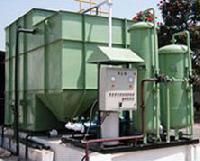
Sewage Treatment Plant
Get Price Quote
We Offer Designing, Fabrication, Installation and Commissioning of Reliable Sewage Water Treatment Plant. to Manufacture Various Components of These Plants, We Utilize Superior Grade Raw Material such as Mild Steel Sheets. Our Commercial Sewage Treatment Plant Uses Aerobic Process for Digestion Rather Than Anaerobic Process Used in Septic Systems. We have Catered to Our Clients for Establishing These Plants Commonly in Rural Areas Where Public Sewers are Not Available that are Used for Single Residence or for a Small Group of Homes. Moreover, We are Listed as One Amidst the Trusted Sewage Water Treatment Manufacturers in India. the Following Process Description and Schematic Flow Diagram Will Assist in the Understanding of the Treatment Processes Used for the Wastewater Treatment Plant. the Wastewater Treatment Plant is Divided Into Five Principal Chambers : anaerobic Chamber - Anaerobic Treatmentaerobic Chamber - Aerobic Treatmentclarification Chamber - Sludge Settlement and Removaldisinfection Chamber - Contact Time with Chlorinepump Out Chamber - Discharge to Disposal System anaerobic Chamber raw Wastewater is Initially Received Into the Anaerobic Chamber. Approximately 30 50% of the Suspended Solids Settle Out in this Chamber Where They Undergo Anaerobic Digestion. the Anaerobic Digestion Process is Carried Out By Microorganisms Which have the Ability to Feed, Grow and Multiply in the Absence of Free Oxygen. in Addition, Settled Sludge and Skimmed Material Returned from the Clarification Chamber are Further Digested in this Chamber. the Plant is Sized to Enable These Microorganisms to Maintain a Sufficient Population Naturally Without the Need for the Addition of Proprietary Biological Products aerobic Chamber the Partially Treated Wastewater, Still Containing the Colloidal and Dissolved Solids Which Represent Approximately 65% of the Pollution Loading, Flows from the Anaerobic Chamber to the Aerobic Chamber. Air is Introduced to the Liquid in this Chamber By Means of a Compressor and Diffusers, Maintaining Aerobic (free Dissolved Oxygen) Conditions. the Oxygen Enriched Effluent Flows About Packs of Submerged Media Having a Large Surface Area On Which Bacteria and other Microorganisms Thrive, Forming a Biological Film. These Microorganisms have a Different Growth Process to Those in the Anaerobic Chamber in that They Utilize the Dissolved Oxygen in the Effluent, While Consuming the Dissolved and Colloidal Organic Matter as Food to Create New Cell Growth and Stable Oxidized Products. the Air Pattern Causes the Liquid in the Chamber to Pass Through the Media in a Discreet Flow Pattern and to have Intimate Contact with the Microorganisms. the Process Differs from Ordinary Suspended Growth Systems in that It is More Stable and also Allows the Growth of Sub-surface Anaerobic Microorganisms Beneath the Surface Film of Aerobic Microorganisms. this Allows Anaerobic Bacterial Action to Check the Media Growth, Thereby Reducing the Biological Sludge Accumulation. Nevertheless, as the Thickening of Material On the Media Occurs, Some Sloughing Off Will Take Place. the Multiple Compartment Design of the Aerobic Chamber Ensures that No Short-circuiting Can Occur, Preventing the Possibility of Partially Treated Wastewater Passing to the Clarification Chamber. the Diffused Aeration System Allows the Air to Be Introduced Below the Media Packs. basically the Reaction in the Aerobic Chamber Converts the Dissolved and Non Settle Able (colloidal) Solids Into Carbon Dioxide and a Biological Floc, Which, Under Quiescent Conditions, Will Settle. clarification Chamber following Aeration, Effluent Flows Into a Circular Hopper Bottomed Clarification Chamber, Where the Biological Floc (or Sludge) Settles Under Quiescent Conditions. Settled Sludge from the Bottom of the Chamber and Floating Material are Returned to the Anaerobic Chamber. from the Clarification Chamber, the Effluent is Drawn Off Below Surface Level and Flows Through the Chlorinator to the Disinfection Chamber. this Continuous Return of Sludge to the Anaerobic Chamber Ensures Continuous Fluid Movement in the Plant Even with Zero Inflow and Keeps the System "live" During Periods of Extended Vacancy. disinfection Chamber the Discharge from the Clarification Chamber Passes Through An Automatic Gravity Chlorinator. the Chlorinator is Calibrated for Above Normal Water Usage. Chlorine Stocks are Provided to Cover Maximum Usage with Built in Safety Factors to Cover all Foreseeable Circumstances Between the Service Periods. the Disinfection Chamber is Designed to Provide a Minimum of 30 Minutes Contact Time Between the Effluent and Chlorine to Ensure Achievement of Bacterial Die-off pump Out Chamber after Disinfection, the Treated Effluent Enters the Pump Out Chamber. the Submersible Pump in this Chamber is Automatically Controlled By a Level Switch to Operate and Shut Down as the Level of the Effluent Rises and Falls.